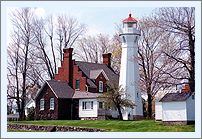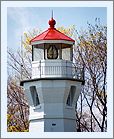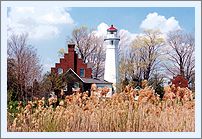|
Historical Information

With the opening of navigation into Lake
Superior through the Sault Lock in 1853, and an increasing number of
vessels being launched to service the increasing commerce, the number of
vessels coasting Lake Huron's southwestern shore increased dramatically
throughout the 1860's. While the 1825 Fort Gratiot Light served to mark
the entrance to the St. Clair River at the foot of the lake, and the
1848 Pointe Aux Barques Light guided vessels around the tip of
Michigan's "Thumb," the intervening 75-mile stretch remained
unlighted, with vessel masters running blind along a forty-mile stretch
of coastline beyond the range of visibility of either of the two Lights.
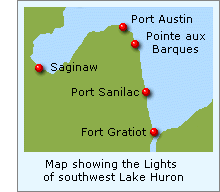 With
pressure from maritime interests, the Lighthouse Board first broached
the need for a Coast Light along this stretch in its 1868 annual report
to Congress, requesting an appropriation of $30,000 to cover the cost of
establishing the station at an as yet undetermined location. While the
Board reiterated the request in each of its four subsequent annual
reports, Congress appears to have been unconvinced of the need for the
station, as no appropriation was forthcoming. However, convinced of the
need for the Light, the Board continued to push for funding, even
increasing the amount of the requested appropriation to $40,000 in its
1873 annual report. With
pressure from maritime interests, the Lighthouse Board first broached
the need for a Coast Light along this stretch in its 1868 annual report
to Congress, requesting an appropriation of $30,000 to cover the cost of
establishing the station at an as yet undetermined location. While the
Board reiterated the request in each of its four subsequent annual
reports, Congress appears to have been unconvinced of the need for the
station, as no appropriation was forthcoming. However, convinced of the
need for the Light, the Board continued to push for funding, even
increasing the amount of the requested appropriation to $40,000 in its
1873 annual report.
While the establishment of the Sand
Beach Harbor of Refuge Light in 1875 reduced the length of unlighted
coastline by approximately sixteen miles, 30 miles of dangerous
coastline remained unlighted, and the Board continued to push for the
funds on an annual basis. Congress finally responded to the Board's
seemingly incessant pleas in 1885. However, they were evidently wary of
the requested costs, as the amount of the appropriation was arbitrarily
reduced to $20,000, a mere half the amount requested.
Selecting Port Sanilac as the optimal
location for the new station, a site selected on high ground at the head
of the small bay. With steps underway for obtaining title to the chosen
site, Eleventh District Engineer Captain Charles E. L. B. Davis set
about creating plans and specifications for construction of the new
station. Amazingly, Davis' plans called not only for a station which
could be built within the tight limitations of the budget, but also
managed to create a design that was both unique and architecturally
significant in its elegance.
Contracts specifying a completion date
of October 15, 1886 were awarded for materials and construction, and the
iron work for the lantern and stairs delivered at the Detroit lighthouse
depot on October 1, 1885. The construction crew arrived at Port Sanilac
on June 7, 1886, and with only four and a half months remaining to
complete the project, work at the site began at a feverish pace. By the
end of June, it was reported tat the cellar had been excavated, the
dwelling walls were almost half raised, the timber and stone foundation
for the tower installed, and all construction materials had been
delivered to the site.
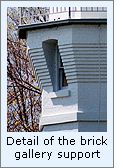 Captain Davis' design called for an
octagonal brick tower standing 14 feet in diameter at the base,
gracefully tapering vertically to a diameter of 9 feet below the
gallery. Instead of supporting the gallery with a series of corbels as
was the custom, twelve successive courses of bricks were laid so as to
stand proud of the course immediately below, creating a flared
"stair-stepped" support for the gallery. Four windows were let
into the flared area to create a watch room from which all quadrants of
the horizon could be observed. Atop the gallery, a prefabricated
octagonal cast iron lantern was erected, and outfitted with a fixed
white Fourth Order Fresnel lens manufactured by Barbier and Fenestre of
Paris. Equipped with a brass reflector on one of its segments, the lens
was installed in such an way that the brass reflector blocked the lens
on the landward side, directing the light out in a 300 degree arc across
the water. Seated at a focal plane of 69 feet, it was calculated that
the light would be visible for a distance of 13 miles at sea. Captain Davis' design called for an
octagonal brick tower standing 14 feet in diameter at the base,
gracefully tapering vertically to a diameter of 9 feet below the
gallery. Instead of supporting the gallery with a series of corbels as
was the custom, twelve successive courses of bricks were laid so as to
stand proud of the course immediately below, creating a flared
"stair-stepped" support for the gallery. Four windows were let
into the flared area to create a watch room from which all quadrants of
the horizon could be observed. Atop the gallery, a prefabricated
octagonal cast iron lantern was erected, and outfitted with a fixed
white Fourth Order Fresnel lens manufactured by Barbier and Fenestre of
Paris. Equipped with a brass reflector on one of its segments, the lens
was installed in such an way that the brass reflector blocked the lens
on the landward side, directing the light out in a 300 degree arc across
the water. Seated at a focal plane of 69 feet, it was calculated that
the light would be visible for a distance of 13 miles at sea.
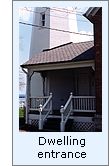 The dwelling was located to the south
of the tower, with the two connected by a covered passageway which also
housed the single entrance to both structures. The gable end walls of
the two story brick dwelling extended vertically above the roof line,
and featured a stair-stepped detail at their upper edge which mirrored
the stepping of the tower gallery support. Erected atop a full cellar,
which served double duty for the storage of both household goods and
lamp oil, which was stored in a separate purpose specific room. The dwelling was located to the south
of the tower, with the two connected by a covered passageway which also
housed the single entrance to both structures. The gable end walls of
the two story brick dwelling extended vertically above the roof line,
and featured a stair-stepped detail at their upper edge which mirrored
the stepping of the tower gallery support. Erected atop a full cellar,
which served double duty for the storage of both household goods and
lamp oil, which was stored in a separate purpose specific room.
Richard W Morris, was promoted to the
position of Acting Keeper of the new Light after serving four years as
the Second Assistant at the Thunder Bay Island
Light, and moved into the
new dwelling on October 6. The construction crew completed their work on
October 13, and Morris climbed the tower to exhibit the light for the
first time on the evening of October 20, 1886. Without no fog signal,
brand new quarters and situated in close proximity to the growing town,
Port Sanilac likely seemed an "Sweetheart" assignment to
Morris after the rigors of life on Thunder Bay Island, and doubtless
Morris and his family quickly settled into a comfortable routine.
To better differentiate the light from
the lights of the town behind the tower, the characteristic of the light
was changed to fixed red on July 15 1889 through the installation of a
ruby-colored glass chimney over the lamp.
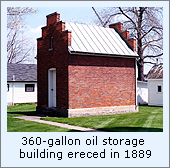 Prior to the 1870's, either
sperm whale or colza oil had been used for the lamps in US lighthouses.
Minimally flammable, and prone to congealing at lower temperatures, the
oil was stored within the dwellings where it would stay warm and its
viscosity low. However, with the change to the significantly more
volatile kerosene, a number of fires had broken-out at stations around
the nation, and the Lighthouse Board embarked on a project of erecting
stand-alone oil storage buildings at all of the nation's lighthouses
through the 1880's and 90's. To this end, a 360-gallon brick oil storage building
was constructed at the station in 1889. Standing 11 feet 10 inches by 16
feet 4 inches in plan. While the Lighthouse Board had two standard plans
to which such structures were normally built, they thoughtfully modified
the plan to include extended gable end walls with the stair-stepped
design to mirror those on the dwelling itself.
Prior to the 1870's, either
sperm whale or colza oil had been used for the lamps in US lighthouses.
Minimally flammable, and prone to congealing at lower temperatures, the
oil was stored within the dwellings where it would stay warm and its
viscosity low. However, with the change to the significantly more
volatile kerosene, a number of fires had broken-out at stations around
the nation, and the Lighthouse Board embarked on a project of erecting
stand-alone oil storage buildings at all of the nation's lighthouses
through the 1880's and 90's. To this end, a 360-gallon brick oil storage building
was constructed at the station in 1889. Standing 11 feet 10 inches by 16
feet 4 inches in plan. While the Lighthouse Board had two standard plans
to which such structures were normally built, they thoughtfully modified
the plan to include extended gable end walls with the stair-stepped
design to mirror those on the dwelling itself.
Keeper Morris resigned from lighthouse
service on May 1, 1893, and was replaced by William H Holmes, another
Thunder Bay Island alumnus, who was promoted to the position after
serving almost six years as First Assistant at the island station.
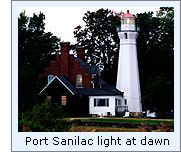 With the availability of reliable
electric power in the town which was growing up around the Light, the
station was electrified in 1924. With electrification, the
characteristic of the Light was changed on the opening of the 1925
navigation season through the installation of an 18,000 candlepower
incandescent electric lamp and electronic timer and switching mechanism.
Thus equipped, the light was set up to exhibit a triple flash every 10
seconds, with a resulting increase in visibility to 16 miles at sea. With the availability of reliable
electric power in the town which was growing up around the Light, the
station was electrified in 1924. With electrification, the
characteristic of the Light was changed on the opening of the 1925
navigation season through the installation of an 18,000 candlepower
incandescent electric lamp and electronic timer and switching mechanism.
Thus equipped, the light was set up to exhibit a triple flash every 10
seconds, with a resulting increase in visibility to 16 miles at sea.
William Holmes passed away in 1926, and
was succeeded by his wife Grace. However, Grace would only tend the
light for two years, as electrification had rendered the services of a
full-time keeper unnecessary, and the position of Keeper of the Port
Sanilac Light was abolished for ever in 1928.
At some time thereafter, the station
buildings passed into private ownership, while the Coast Guard maintains
access to the tower and lantern, which continues to house the original
1886 Forth Order lens.

Keepers of
this Light

Click here
to see a complete listing of all Port Sanilac Light keepers compiled by
Phyllis L. Tag of Great Lakes Lighthouse Research.

Seeing this Light

Port Sanilac on a beautiful Friday Spring
afternoon found the marina in front of the lighthouse bustling with
activity. Boat owners busy preparing their proud craft for what had all
the earmarks of being an unseasonably warm weekend, the marina crew busy
bringing boats out of water storage, and trucks carrying stone out onto
the breakwater. An island of calm in the midst of all this activity, the
Sanilac Light sat observing everything going on around it as it has for
the past one hundred and fourteen years.
Port Sanilac is a beautiful little village, tight on the coast of Lake
Huron, and features a number of quaint, older buildings, likely
contemporary to the lighthouse.
We walked out on the breakwater to the point at which the trucks were
unloading their stone, and could go no further. We then walked into the
marina and took a couple of photographs from the docks. Unfortunately,
the Port Sanilac museum, which is located in a large house south of town
on M25, was closed until summer. Thus, unable to add to our limited
knowledge of the history of the lighthouse, we have a good excuse to
return again!

Finding this
Light

From the traffic light on M-25, go east one block to Lake Street and
turn right (south) two blocks. The Light sits on the East side of the
street, and there is a public breakwater parking area immediately to the
South of the Light.

 Reference
Sources Reference
Sources

Annual reports of the Lighthouse Board, 1867 - 1909
Lake Carrier's Association annual reports, 1910 - 1928
Northern Lights, Charles K. Hyde, 1986
Personal visits to Port Sanilac, May 2000 & September 2002
Photographs from the author's personal collection.
Keeper listings for this light appear
courtesy of Tom & Phyllis Tag
|
